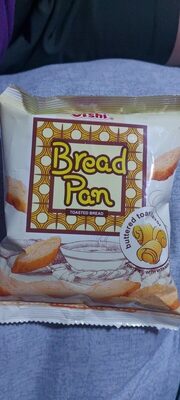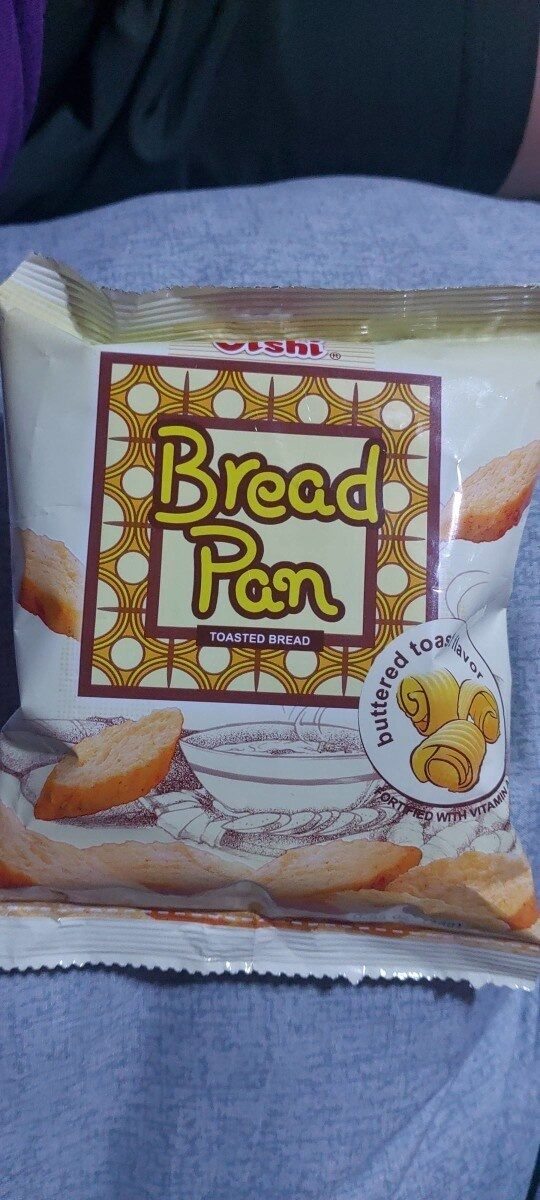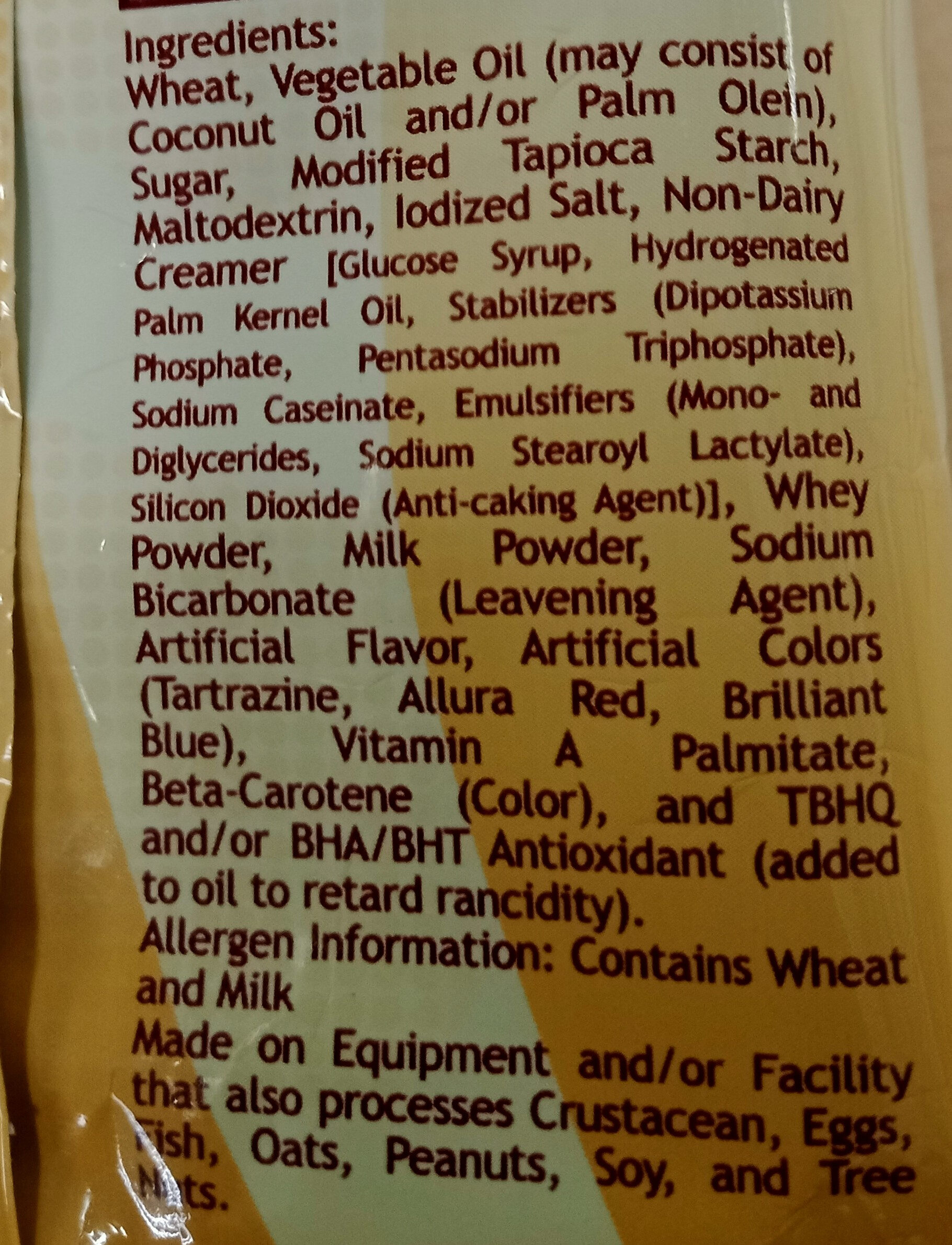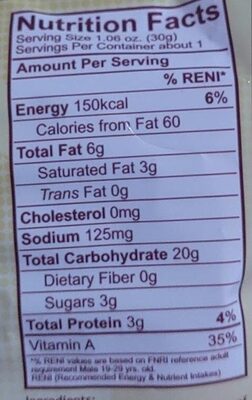Help us make food transparency the norm!
As a non-profit organization, we depend on your donations to continue informing consumers around the world about what they eat.
The food revolution starts with you!
Bread Pan - Oishi - 24g
Bread Pan - Oishi - 24g
This product page is not complete. You can help to complete it by editing it and adding more data from the photos we have, or by taking more photos using the app for Android or iPhone/iPad. Thank you!
×
Barcode: 4800194153683 (EAN / EAN-13)
Quantity: 24g
Packaging: Aluminum foil pack
Brands: Oishi
Categories: Toaste breads
Origin of ingredients: Philippines
Link to the product page on the official site of the producer: http://www.facebook.com/oishi.ph
Countries where sold: Philippines
Matching with your preferences
Health
Ingredients
-
28 ingredients
Wheat, Vegetable Oil (may consist of Coconut Õil and/or Palm Olein). Maltodextrin, lodized Salt, Non-Dairy Creamer [Glucose Syrup, Hydrogenated Palm Kernel Oil, Stabilizers (Dipotassium Phosphate, Pentasodium Triphosphate), Sodium Caseinate, Emulsifiers (Mono - and Diglycerides, Sodium Stearoyl Lactylate), Silicon Dioxide (Anti-caking Agent)], Whey Powder, Milk Bicarbonate Artificial Flavor, Artificial Colors (Tartrazine, Allura Red, Brilliant Blue), Beta-Carotene (Color), and TBHQ and/or BHA/BHT Antioxidant (added to oil to retard rancidity).Allergens: GlutenTraces: Eggs, Gluten, Peanuts, Soybeans, Leavening-agent, Allergen-information-contains-wheat-and-milk-made-on-equipment-and-or-facility-that-also-processes-crustacean, Vitamin-a-palmitate, And-tree-ts-sodium-powder, Ish
Food processing
-
Ultra processed foods
Elements that indicate the product is in the 4 - Ultra processed food and drink products group:
- Additive: E102 - Tartrazine
- Additive: E129 - Allura red
- Additive: E160a - Carotene
- Additive: E451 - Triphosphates
- Additive: E471 - Mono- and diglycerides of fatty acids
- Additive: E481 - Sodium stearoyl-2-lactylate
- Ingredient: Colour
- Ingredient: Emulsifier
- Ingredient: Glucose
- Ingredient: Glucose syrup
- Ingredient: Maltodextrin
- Ingredient: Whey
Food products are classified into 4 groups according to their degree of processing:
- Unprocessed or minimally processed foods
- Processed culinary ingredients
- Processed foods
- Ultra processed foods
The determination of the group is based on the category of the product and on the ingredients it contains.
Additives
-
E102 - Tartrazine
Tartrazine: Tartrazine is a synthetic lemon yellow azo dye primarily used as a food coloring. It is also known as E number E102, C.I. 19140, FD&C Yellow 5, Acid Yellow 23, Food Yellow 4, and trisodium 1--4-sulfonatophenyl--4--4-sulfonatophenylazo--5-pyrazolone-3-carboxylate-.Tartrazine is a commonly used color all over the world, mainly for yellow, and can also be used with Brilliant Blue FCF -FD&C Blue 1, E133- or Green S -E142- to produce various green shades.Source: Wikipedia
-
E129 - Allura red
Allura Red AC: Allura Red AC is a red azo dye that goes by several names, including FD&C Red 40. It is used as a food dye and has the E number E129. It is usually supplied as its red sodium salt, but can also be used as the calcium and potassium salts. These salts are soluble in water. In solution, its maximum absorbance lies at about 504 nm.Source: Wikipedia
-
E160a - Carotene
Carotene: The term carotene -also carotin, from the Latin carota, "carrot"- is used for many related unsaturated hydrocarbon substances having the formula C40Hx, which are synthesized by plants but in general cannot be made by animals -with the exception of some aphids and spider mites which acquired the synthesizing genes from fungi-. Carotenes are photosynthetic pigments important for photosynthesis. Carotenes contain no oxygen atoms. They absorb ultraviolet, violet, and blue light and scatter orange or red light, and -in low concentrations- yellow light. Carotenes are responsible for the orange colour of the carrot, for which this class of chemicals is named, and for the colours of many other fruits, vegetables and fungi -for example, sweet potatoes, chanterelle and orange cantaloupe melon-. Carotenes are also responsible for the orange -but not all of the yellow- colours in dry foliage. They also -in lower concentrations- impart the yellow coloration to milk-fat and butter. Omnivorous animal species which are relatively poor converters of coloured dietary carotenoids to colourless retinoids have yellowed-coloured body fat, as a result of the carotenoid retention from the vegetable portion of their diet. The typical yellow-coloured fat of humans and chickens is a result of fat storage of carotenes from their diets. Carotenes contribute to photosynthesis by transmitting the light energy they absorb to chlorophyll. They also protect plant tissues by helping to absorb the energy from singlet oxygen, an excited form of the oxygen molecule O2 which is formed during photosynthesis. β-Carotene is composed of two retinyl groups, and is broken down in the mucosa of the human small intestine by β-carotene 15‚15'-monooxygenase to retinal, a form of vitamin A. β-Carotene can be stored in the liver and body fat and converted to retinal as needed, thus making it a form of vitamin A for humans and some other mammals. The carotenes α-carotene and γ-carotene, due to their single retinyl group -β-ionone ring-, also have some vitamin A activity -though less than β-carotene-, as does the xanthophyll carotenoid β-cryptoxanthin. All other carotenoids, including lycopene, have no beta-ring and thus no vitamin A activity -although they may have antioxidant activity and thus biological activity in other ways-. Animal species differ greatly in their ability to convert retinyl -beta-ionone- containing carotenoids to retinals. Carnivores in general are poor converters of dietary ionone-containing carotenoids. Pure carnivores such as ferrets lack β-carotene 15‚15'-monooxygenase and cannot convert any carotenoids to retinals at all -resulting in carotenes not being a form of vitamin A for this species-; while cats can convert a trace of β-carotene to retinol, although the amount is totally insufficient for meeting their daily retinol needs.Source: Wikipedia
-
E160ai - Beta-carotene
Beta-Carotene: β-Carotene is an organic, strongly colored red-orange pigment abundant in plants and fruits. It is a member of the carotenes, which are terpenoids -isoprenoids-, synthesized biochemically from eight isoprene units and thus having 40 carbons. Among the carotenes, β-carotene is distinguished by having beta-rings at both ends of the molecule. β-Carotene is biosynthesized from geranylgeranyl pyrophosphate.β-Carotene is the most common form of carotene in plants. When used as a food coloring, it has the E number E160a. The structure was deduced by Karrer et al. in 1930. In nature, β-carotene is a precursor -inactive form- to vitamin A via the action of beta-carotene 15‚15'-monooxygenase.Isolation of β-carotene from fruits abundant in carotenoids is commonly done using column chromatography. It can also be extracted from the beta-carotene rich algae, Dunaliella salina. The separation of β-carotene from the mixture of other carotenoids is based on the polarity of a compound. β-Carotene is a non-polar compound, so it is separated with a non-polar solvent such as hexane. Being highly conjugated, it is deeply colored, and as a hydrocarbon lacking functional groups, it is very lipophilic.Source: Wikipedia
-
E320 - Butylated hydroxyanisole (bha)
Butylated hydroxyanisole: Butylated hydroxyanisole -BHA- is an antioxidant consisting of a mixture of two isomeric organic compounds, 2-tert-butyl-4-hydroxyanisole and 3-tert-butyl-4-hydroxyanisole. It is prepared from 4-methoxyphenol and isobutylene. It is a waxy solid used as a food additive with the E number E320. The primary use for BHA is as an antioxidant and preservative in food, food packaging, animal feed, cosmetics, rubber, and petroleum products. BHA also is commonly used in medicines, such as isotretinoin, lovastatin, and simvastatin, among others.Source: Wikipedia
-
E340 - Potassium phosphates
Potassium phosphate: Potassium phosphate is a generic term for the salts of potassium and phosphate ions including: Monopotassium phosphate -KH2PO4- -Molar mass approx: 136 g/mol- Dipotassium phosphate -K2HPO4- -Molar mass approx: 174 g/mol- Tripotassium phosphate -K3PO4- -Molar mass approx: 212.27 g/mol-As food additives, potassium phosphates have the E number E340.Source: Wikipedia
-
E340ii - Dipotassium phosphate
Potassium phosphate: Potassium phosphate is a generic term for the salts of potassium and phosphate ions including: Monopotassium phosphate -KH2PO4- -Molar mass approx: 136 g/mol- Dipotassium phosphate -K2HPO4- -Molar mass approx: 174 g/mol- Tripotassium phosphate -K3PO4- -Molar mass approx: 212.27 g/mol-As food additives, potassium phosphates have the E number E340.Source: Wikipedia
-
E451 - Triphosphates
Sodium triphosphate: Sodium triphosphate -STP-, also sodium tripolyphosphate -STPP-, or tripolyphosphate -TPP-,- is an inorganic compound with formula Na5P3O10. It is the sodium salt of the polyphosphate penta-anion, which is the conjugate base of triphosphoric acid. It is produced on a large scale as a component of many domestic and industrial products, especially detergents. Environmental problems associated with eutrophication are attributed to its widespread use.Source: Wikipedia
-
E451i - Pentasodium triphosphate
Sodium triphosphate: Sodium triphosphate -STP-, also sodium tripolyphosphate -STPP-, or tripolyphosphate -TPP-,- is an inorganic compound with formula Na5P3O10. It is the sodium salt of the polyphosphate penta-anion, which is the conjugate base of triphosphoric acid. It is produced on a large scale as a component of many domestic and industrial products, especially detergents. Environmental problems associated with eutrophication are attributed to its widespread use.Source: Wikipedia
-
E471 - Mono- and diglycerides of fatty acids
Mono- and diglycerides of fatty acids (E471), are food additives commonly used as emulsifiers in various processed foods.
These compounds consist of glycerol molecules linked to one or two fatty acid chains, which help stabilize and blend water and oil-based ingredients. E471 enhances the texture and shelf life of products like margarine, baked goods, and ice cream, ensuring a smooth and consistent texture.
It is generally considered safe for consumption within established regulatory limits.
-
E481 - Sodium stearoyl-2-lactylate
Sodium stearoyl lactylate: Sodium stearoyl-2-lactylate -sodium stearoyl lactylate or SSL- is a versatile, FDA approved food additive used to improve the mix tolerance and volume of processed foods. It is one type of a commercially available lactylate. SSL is non-toxic, biodegradable, and typically manufactured using biorenewable feedstocks. Because SSL is a safe and highly effective food additive, it is used in a wide variety of products ranging from baked goods and desserts to pet foods.As described by the Food Chemicals Codex 7th edition, SSL is a cream-colored powder or brittle solid. SSL is currently manufactured by the esterification of stearic acid with lactic acid and partially neutralized with either food-grade soda ash -sodium carbonate- or caustic soda -concentrated sodium hydroxide-. Commercial grade SSL is a mixture of sodium salts of stearoyl lactylic acids and minor proportions of other sodium salts of related acids. The HLB for SSL is 10-12. SSL is slightly hygroscopic, soluble in ethanol and in hot oil or fat, and dispersible in warm water. These properties are the reason that SSL is an excellent emulsifier for fat-in-water emulsions and can also function as a humectant.Source: Wikipedia
Ingredients analysis
-
Palm oil
Ingredients that contain palm oil: Hydrogenated palm kernel oil
-
Non-vegan
Non-vegan ingredients: Sodium caseinate, Whey powderSome ingredients could not be recognized.
We need your help!
You can help us recognize more ingredients and better analyze the list of ingredients for this product and others:
- Edit this product page to correct spelling mistakes in the ingredients list, and/or to remove ingredients in other languages and sentences that are not related to the ingredients.
- Add new entries, synonyms or translations to our multilingual lists of ingredients, ingredient processing methods, and labels.
If you would like to help, join the #ingredients channel on our Slack discussion space and/or learn about ingredients analysis on our wiki. Thank you!
-
Vegetarian status unknown
Unrecognized ingredients: May-consist-of-coconut-oil-and-palm-olein, Lodized-salt, Non-dairy-creamer, Milk-bicarbonate-artificial-flavor, Brilliant-blue, And-tbhq-and-bha, Bht-antioxidant, Added-to-oil-to-retard-ranciditySome ingredients could not be recognized.
We need your help!
You can help us recognize more ingredients and better analyze the list of ingredients for this product and others:
- Edit this product page to correct spelling mistakes in the ingredients list, and/or to remove ingredients in other languages and sentences that are not related to the ingredients.
- Add new entries, synonyms or translations to our multilingual lists of ingredients, ingredient processing methods, and labels.
If you would like to help, join the #ingredients channel on our Slack discussion space and/or learn about ingredients analysis on our wiki. Thank you!
-
Details of the analysis of the ingredients
We need your help!
Some ingredients could not be recognized.
We need your help!
You can help us recognize more ingredients and better analyze the list of ingredients for this product and others:
- Edit this product page to correct spelling mistakes in the ingredients list, and/or to remove ingredients in other languages and sentences that are not related to the ingredients.
- Add new entries, synonyms or translations to our multilingual lists of ingredients, ingredient processing methods, and labels.
If you would like to help, join the #ingredients channel on our Slack discussion space and/or learn about ingredients analysis on our wiki. Thank you!
: Wheat, Vegetable Oil (may consist of Coconut Õil and Palm Olein), Maltodextrin, lodized Salt, Non-Dairy Creamer (Glucose Syrup, Hydrogenated Palm Kernel Oil, Stabilizers (Dipotassium Phosphate, Pentasodium Triphosphate), Sodium Caseinate, Emulsifiers (mono- and Diglycerides, Sodium Stearoyl Lactylate), Silicon Dioxide (Anti-caking Agent)), Whey Powder, Milk Bicarbonate Artificial Flavor, Artificial Colors (Tartrazine, Allura Red, Brilliant Blue), Beta-Carotene (Color), and TBHQ and BHA, BHT Antioxidant (added to oil to retard rancidity)- Wheat -> en:wheat - vegan: yes - vegetarian: yes - ciqual_proxy_food_code: 9410 - percent_min: 9.09090909090909 - percent_max: 100
- Vegetable Oil -> en:vegetable-oil - vegan: yes - vegetarian: yes - from_palm_oil: maybe - percent_min: 0 - percent_max: 50
- may consist of Coconut Õil and Palm Olein -> en:may-consist-of-coconut-oil-and-palm-olein - percent_min: 0 - percent_max: 50
- Maltodextrin -> en:maltodextrin - vegan: yes - vegetarian: yes - percent_min: 0 - percent_max: 33.3333333333333
- lodized Salt -> en:lodized-salt - percent_min: 0 - percent_max: 25
- Non-Dairy Creamer -> en:non-dairy-creamer - percent_min: 0 - percent_max: 20
- Glucose Syrup -> en:glucose-syrup - vegan: yes - vegetarian: yes - ciqual_proxy_food_code: 31016 - percent_min: 0 - percent_max: 20
- Hydrogenated Palm Kernel Oil -> en:hydrogenated-palm-kernel-oil - vegan: yes - vegetarian: yes - from_palm_oil: yes - percent_min: 0 - percent_max: 10
- Stabilizers -> en:stabiliser - percent_min: 0 - percent_max: 6.66666666666667
- Dipotassium Phosphate -> en:e340ii - vegan: yes - vegetarian: yes - percent_min: 0 - percent_max: 6.66666666666667
- Pentasodium Triphosphate -> en:e451i - vegan: yes - vegetarian: yes - percent_min: 0 - percent_max: 3.33333333333333
- Sodium Caseinate -> en:sodium-caseinate - vegan: no - vegetarian: yes - percent_min: 0 - percent_max: 5
- Emulsifiers -> en:emulsifier - percent_min: 0 - percent_max: 4
- mono- and Diglycerides -> en:e471 - vegan: maybe - vegetarian: maybe - from_palm_oil: maybe - percent_min: 0 - percent_max: 4
- Sodium Stearoyl Lactylate -> en:e481 - vegan: maybe - vegetarian: maybe - from_palm_oil: maybe - percent_min: 0 - percent_max: 2
- Silicon Dioxide -> en:e551 - vegan: yes - vegetarian: yes - percent_min: 0 - percent_max: 3.33333333333333
- Anti-caking Agent -> en:anti-caking-agent - percent_min: 0 - percent_max: 3.33333333333333
- Whey Powder -> en:whey-powder - vegan: no - vegetarian: maybe - percent_min: 0 - percent_max: 16.6666666666667
- Milk Bicarbonate Artificial Flavor -> en:milk-bicarbonate-artificial-flavor - percent_min: 0 - percent_max: 14.2857142857143
- Artificial Colors -> en:colour - percent_min: 0 - percent_max: 12.5
- Tartrazine -> en:e102 - vegan: yes - vegetarian: yes - percent_min: 0 - percent_max: 12.5
- Allura Red -> en:e129 - vegan: yes - vegetarian: yes - percent_min: 0 - percent_max: 6.25
- Brilliant Blue -> en:brilliant-blue - percent_min: 0 - percent_max: 4.16666666666667
- Beta-Carotene -> en:e160ai - vegan: maybe - vegetarian: maybe - from_palm_oil: maybe - percent_min: 0 - percent_max: 11.1111111111111
- Color -> en:colour - percent_min: 0 - percent_max: 11.1111111111111
- and TBHQ and BHA -> en:and-tbhq-and-bha - percent_min: 0 - percent_max: 10
- BHT Antioxidant -> en:bht-antioxidant - percent_min: 0 - percent_max: 9.09090909090909
- added to oil to retard rancidity -> en:added-to-oil-to-retard-rancidity - percent_min: 0 - percent_max: 9.09090909090909
Nutrition
-
Good nutritional quality
⚠ ️Warning: the amount of fruits, vegetables and nuts is not specified on the label, it was estimated from the list of ingredients: 0This product is not considered a beverage for the calculation of the Nutri-Score.
Positive points: 1
- Proteins: 1 / 5 (value: 3, rounded value: 3)
- Fiber: 0 / 5 (value: 0, rounded value: 0)
- Fruits, vegetables, nuts, and colza/walnut/olive oils: 0 / 5 (value: 0, rounded value: 0)
Negative points: 3
- Energy: 1 / 10 (value: 628, rounded value: 628)
- Sugars: 0 / 10 (value: 3, rounded value: 3)
- Saturated fat: 2 / 10 (value: 3, rounded value: 3)
- Sodium: 0 / 10 (value: 0, rounded value: 0)
The points for proteins are counted because the negative points are less than 11.
Nutritional score: (3 - 1)
Nutri-Score:
-
Nutrient levels
-
Fat in moderate quantity (6%)
What you need to know- A high consumption of fat, especially saturated fats, can raise cholesterol, which increases the risk of heart diseases.
Recommendation: Limit the consumption of fat and saturated fat- Choose products with lower fat and saturated fat content.
-
Saturated fat in moderate quantity (3%)
What you need to know- A high consumption of fat, especially saturated fats, can raise cholesterol, which increases the risk of heart diseases.
Recommendation: Limit the consumption of fat and saturated fat- Choose products with lower fat and saturated fat content.
-
Sugars in low quantity (3%)
What you need to know- A high consumption of sugar can cause weight gain and tooth decay. It also augments the risk of type 2 diabetes and cardio-vascular diseases.
Recommendation: Limit the consumption of sugar and sugary drinks- Sugary drinks (such as sodas, fruit beverages, and fruit juices and nectars) should be limited as much as possible (no more than 1 glass a day).
- Choose products with lower sugar content and reduce the consumption of products with added sugars.
-
Salt in low quantity (0%)
What you need to know- A high consumption of salt (or sodium) can cause raised blood pressure, which can increase the risk of heart disease and stroke.
- Many people who have high blood pressure do not know it, as there are often no symptoms.
- Most people consume too much salt (on average 9 to 12 grams per day), around twice the recommended maximum level of intake.
Recommendation: Limit the consumption of salt and salted food- Reduce the quantity of salt used when cooking, and don't salt again at the table.
- Limit the consumption of salty snacks and choose products with lower salt content.
-
-
Nutrition facts
Nutrition facts As sold
for 100 g / 100 mlAs sold
per serving (30g)Energy 628 kj
(150 kcal)188 kj
(45 kcal)Fat 6 g 1.8 g Saturated fat 3 g 0.9 g Carbohydrates 20 g 6 g Sugars 3 g 0.9 g Fiber 0 g 0 g Proteins 3 g 0.9 g Salt 0 g 0 g Fruits‚ vegetables‚ nuts and rapeseed‚ walnut and olive oils (estimate from ingredients list analysis) 0 % 0 %
Environment
-
Eco-Score not computed - Unknown environmental impact
We could not compute the Eco-Score of this product as it is missing some data, could you help complete it?Could you add a precise product category so that we can compute the Eco-Score? Add a category
Packaging
-
Packaging with a medium impact
-
Packaging parts
Packet
-
Packaging materials
Material % Packaging weight Packaging weight per 100 g of product
-
Transportation
-
Origins of ingredients
Origins of ingredients with a high impact
Origin of the product and/or its ingredients % of ingredients Impact Philippines 100 %High
Threatened species
-
Contains palm oil
Drives deforestation and threatens species such as the orangutan
Tropical forests in Asia, Africa and Latin America are destroyed to create and expand oil palm tree plantations. The deforestation contributes to climate change, and it endangers species such as the orangutan, the pigmy elephant and the Sumatran rhino.
Report a problem
-
Incomplete or incorrect information?
Category, labels, ingredients, allergens, nutritional information, photos etc.
If the information does not match the information on the packaging, please complete or correct it. Open Food Facts is a collaborative database, and every contribution is useful for all.
Data sources
Product added on by antoniojr
Last edit of product page on by kiliweb.
Product page also edited by openfoodfacts-contributors, yuka.sY2b0xO6T85zoF3NwEKvlkZADfaBrRnNKkHggUjR54-yLrjuUPxosq_-Iqs, yuka.sY2b0xO6T85zoF3NwEKvllRnc9bu8zTkLD36wxOFzc2nd7fDT_NL4LbaIqs.










